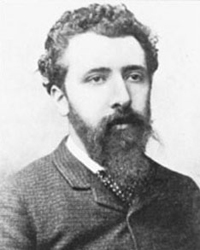Although his artistic career lasted only a decade, Georges Seurat’s influence has stood the test of time. Popularized with his famous work “Sunday Afternoon on the Island of La Grande Jatte,” his method of painting with precisely placed small dots is a famous and often imitated technique, blending science and beauty on a single canvas.
Georges Seurat’s Early Days
Georges-Pierre Seurat was born in Paris on December 2, 1859, the third child of wealthy parents. Perhaps because an elder brother had died at age five, Seurat was doted on by his mother, who delighted in taking her son to visit the beautifully landscaped gardens that dotted the city in the mid-1800s.
Although his mother lavished attention on young Seurat, his father was withdrawn, spending most of his time at a country villa and only returning on Tuesdays to visit his family.
When he was 18, Seurat entered École des Beaux-Arts, a renowned Parisian art academy. He left a year later in 1879 for his state-mandated military service in the port of Brest. He spent that time making sketches of his companions and surroundings.
Sources in this Story
- WetCanvas: Georges Seurat: The Quiet Experimenter
- wiseGEEK: What is Pointillism?
- The Art Institute of Chicago: Seurat and the Making of La Grande Jatte
- Khan Academy: Seurat, A Sunday on La Grande Jatte
- The Metropolitan Museum of Art: Georges Seurat (1859–1891) and Neo-Impressionism
- Centers for Disease Control and Prevention: Death of Seurat
Seurat’s Notable Accomplishments
As he entered his twenties, Seurat defined himself as a professional artist. Thanks to a very generous monthly stipend from his parents, he did not need to learn a trade or seek gainful employment. Instead he busied himself with creating small oil paintings and black-and-white drawings. Even in his earliest works, Seurat experimented with color theory, attempting to use contrasts and color complements to enhance his paintings.
After secluding himself in his studio and working for a year, Seurat unveiled his first large painting, “Bathing Place, Asnières,” in 1883; it portrayed men and boys relaxing along the banks of the River Seine. Seurat very methodically created more than 13 preparatory sketches and studies for the 6-by-9-foot painting. This careful, scientific approach became the hallmark of Seurat’s artistic process.
Seurat used several different techniques used by the Impressionists of the time to paint “Bathing Place.” In spots, he used broad strokes and in other places, he employed very small monochromatic dots intended to trick the eye into blending them into other colors. It was in these portions of the painting that the very first example of pointillism was seen in a major work.
The painting was rejected by the Salon, France’s prominent art show, and in response Seurat and his friends, Maximilien Luce and Paul Signac among others, formed a rival art show and society, the Société des Artistes Indépendants. Inspired by his new cohorts, Seurat began to refine his pointillism technique, spending hours discussing the scientific reasoning behind this method with his friend Signac. In 1884, he began the first of many studies he used to create his most famous work, “Sunday Afternoon on the Island of La Grande Jatte.”
Every day for years, Seurat would travel to the island of la Grande Jatte to sketch and every afternoon he would work in his studio. He was methodical to a degree not typically seen in artists. Some speculate his affluence afforded him the luxury of painting so slowly.
La Grande Jatte debuted at the Eighth Annual Impressionist Exhibition. In a Khan Academy video that analyzes the painting and discussing how it was made, Dr. Steven Zucker noted that the painting “caused a real stir” when it debuted, with artists dividing into camps for an against it. Dr. Beth Harris explained that the painting was very different from the impressionist work popular at the time. “It exploded what the most advanced art of the time was,” she said.
Several others, such as Signac and Camille Pissarro, painted in similar color-focused styles and the group became known as the scientific Impressionists or, later, the Neo-Impressionists.
Committed to his painting method, Seurat moved to the artistic enclave of Montmartre, quietly producing one large work each year while others furiously debated his techniques. During his lifetime, Seurat painted seven large paintings, 60 smaller ones and numerous sketches.
The Man and his Work
- “Georges Seurat: The Drawings”
- “Seurat and the Making of La Grande Jatte” by Robert L. Herbert
- “Seurat and the Avant-garde” by Paul Smith
- “Seurat and La Grande Jatte: Connecting the Dots” by Robert Burleigh
- “Sunday in the Park with George” (DVD)
The Rest of the Story
Very few people knew when the secretive Seurat began living with a woman, Madeleine Knobloch, and it was almost a complete secret when she bore him a child. Seurat named the child after himself, but failed to introduce his new family to his mother, father or friends. Even when he painted Knobloch, he exhibited the piece without identifying his subject.
In March 1891, Seurat became ill and was forced to bring his two families together. He moved—along with the pregnant Knobloch—to his mother’s apartments where he became bedridden. Doctors diagnosed him with “infectious angina or quinsy”; a contemporary researcher suggests that Seurat probably had diphtheria. He died early on Easter Sunday, March 29, 1891, at the age of 31. Both of his children died soon after.
In 1984, “Sunday in the Park with George,” acclaimed composer Stephen Sondheim’s fanciful recreation of the process of creating “La Grande Jatte,” opened on Broadway. The musical has since been produced several times. The famous painting itself remains on display at the Art Institute of Chicago.
This article was originally written by Jennifer Ferris; it was updated December 4, 2017.











